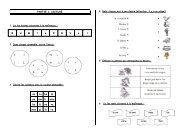Create successful ePaper yourself
Turn your PDF publications into a flip-book with our unique Google optimized e-Paper software.
Predator Avoidance: CamouflageLesson ThirteenAges Primary <strong>and</strong> IntermediateObjective: Students will underst<strong>and</strong> how camouflage works.Materials:TapeCrayons <strong>and</strong>/or MarkersScissorsDrawing paperSuggested Approach:1. Review camouflage briefly with the class.Some animals (for example, birds, bats, spiders, dragonflies, <strong>and</strong> mice) rely heavily onLepidoptera for food. <strong>Butterflies</strong> <strong>and</strong> moths have evolved several strategies to keep frombeing eaten. These include:Warning coloration- a bold pattern <strong>and</strong> bright contrasting colors. Bright warning coloration,especially yellow-<strong>and</strong>-black, orange, or red, warn birds <strong>and</strong> other predators that such insectsmay bite, sting, or taste bad.Camouflage- <strong>Moths</strong> <strong>and</strong> many butterflies, particularly females, have earth-tone colors orpatterns that resemble tree bark, lichens, or leaves. This “cryptic coloration” allows them toavoid predators by blending into their surroundings.Mimicry- Some butterflies <strong>and</strong> moths deter predators by mimicking the color pattern of otherless edible species or other insects, plants, <strong>and</strong> animals.Two types of mimicry:1) Batesian MimicrySome harmless Lepidoptera species mimic the appearance of other species that arepoisonous or distasteful. They “pretend” to be poisonous <strong>and</strong> predators avoid them.2) Mullerian MimicrySometimes two species look alike <strong>and</strong> both are poisonous or distasteful. When apredator attacks one of the two, it remembers the color pattern <strong>and</strong> is unlikely toattack either, avoiding insects with that color pattern.Defense patterns- Alarm Patterns: Eyespots on wings intimidate predators, especially smallbirds, who think they see the eye of a larger bird that might harm them.Florida Museum of Natural History http://www.flmnh.ufl.edu 46
















